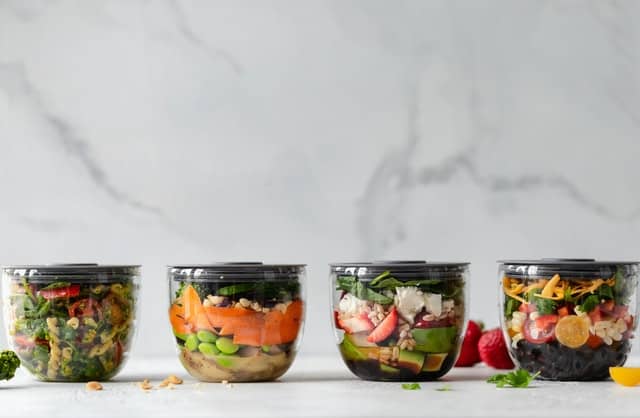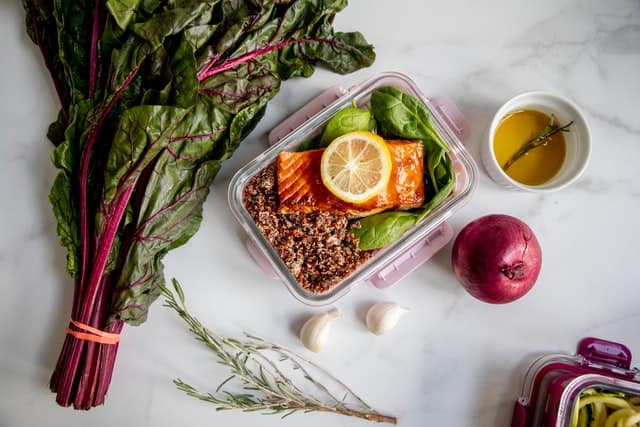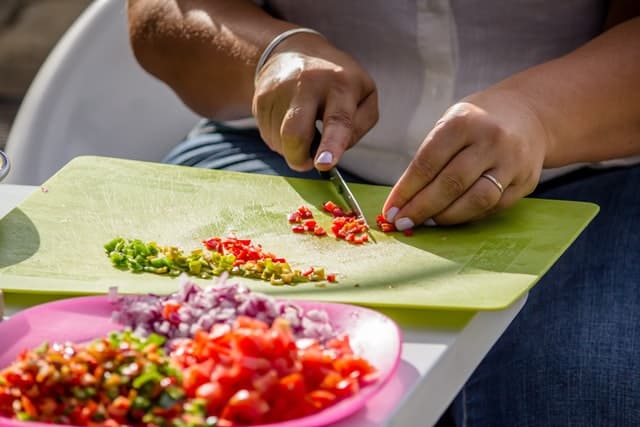Picture plain chicken breast, broccoli, and brown rice in small plastic containers, stacked in the fridge. Lightly dressed spring mix salads for lunch 7 days a week. All healthy, but so boring and lame, right? It’s so easy to feel trapped and pigeonholed into healthy eating or a little intimidating to even start because everyone and their brother has a different view backed by science or a celebrity spokesperson. Every healthy eating advocate swears up and down that they have a special secret to daily food intake.
Honestly, it’s simple if you strip it down to the very basics. I believe that the most important thing is to have a healthy relationship with food. I want for you to learn how to eat a balanced and healthy diet with consistency by developing and maintaining a healthy relationship with and understanding of food. Below, I have super practical tips that will set your relationship straight with food and what it means to be healthy. I’m even going to share my daily food intake with you too!
Let’s get cooking!
This post may contain affiliate links which means I’ll receive a commission if you purchase through my links, at no extra cost to you. Please read full disclosure for more information.

My Daily Food Intake
Here’s an example of what I may eat on any given day- a super basic list of my daily food intake:
Breakfast- 3 eggs over easy with one slice of Aldi’s L’Oven Fresh Protein Bread topped with a smear of cream cheese and strawberry jam, and black coffee.
Morning snack- a piece of fruit, or ¾ cup of plain greek yogurt (with a squirt of honey or agave, sprinkle of cinnamon, and a bit of vanilla extract).
Lunch- usually last night’s leftovers, or maybe a Muscle Milk or Kirkland’s protein bar/Quest bar with mixed nuts (1 oz) and one serving of pretzel thins (about 1 oz which equals 11 pretzels), a piece of fruit, and maybe a bell pepper or some baby carrots.
Afternoon snack- 2 cups of Simply Nature Sea Salt popcorn from Aldi.
Dinner- Parmesan-crusted chicken, roasted potatoes, and green beans.
Evening snack- a Yasso Greek yogurt bar or Halo Top ice cream.
| Related Reading: How to Eat Healthy Without Going on a Diet: The Ultimate Guide
I typically cook a few different healthy recipes on Sundays in preparation for the week ahead. And I don’t mind eating the same things all week long. (Meal prep is an excellent way to stick to a healthy diet. If you don’t like the idea of “meal prepping” just look at it as extra cooking on Sunday so you can have quick, healthy meals all week long!)
Now obviously, my meals differ each day/week, but I try to stick to a general guideline.
(If you want a super helpful guideline of how to eat according to your cycle and tips for eating food to honor your hormones, I highly recommend the book Woman Code by Alisa Vitti. It’s totally enlightening and a super unique, science-backed way to eat that honors your body.)
The Basic Format of my Food Intake
- Breakfast- 3 servings of protein, 1-2 servings of carbs, 3 servings of fat
- Lunch- 3 servings of protein, 2 servings of carbs, 1 serving of fruit, an optional serving of veg, and 3 servings of fat
- Dinner- 6 servings of protein, 1 serving of carbs, 1-3 servings of fat, 2-3 servings of veg.
- With healthy snacks in between that are high(ish) in protein (because I’m always hungry).
Note: 1 serving of protein is 1 oz or 8 grams of protein, 1 serving of carbs is 15 grams of carbs, 1 serving of fat is 5 grams of fat, 1 serving of fruit is roughly one piece of fruit or 1 cup of fruit, and 1 serving of vegetables is ½ cup or 1 cup of leafy greens. I got these measurements based on a program I did a while back called JCore (loved it! Find it here). These measurements are not mine, and not made up, they’re actual, true measurements.
My entire diet is based loosely on this program, but over time, I adapted it to fit my needs and hunger level. I have a big appetite, fast metabolism, and I’m always hungry!
Keep in mind that the amount I eat is based on my height and weight, and my activity level (I work out about 4 times per week). So my diet and the amount I eat will be much different than yours!
Also keep in mind that what I eat, or what someone else eats isn’t always right for you. It’s helpful to know to what extent you should mind your own business in terms of others’ food intake. Do what’s right and healthy for your body.
Now that you know what I eat in a day, let’s talk more about why.

Relationship with Food
I truly believe that living a healthy lifestyle and eating healthy doesn’t have to be super complicated and I view relationship with food as the number one most important factor when it comes to eating healthy.
I’m a believer in giving your body the nutrients it needs through a daily food intake of enough food that is genuinely good for your body.
Your relationship with food should be based on the foundation that your body requires certain nutrients, and a certain amount of food to function properly. This cannot be achieved by making food the bad guy, but it can be achieved by understanding that eating healthy can taste good and become a lifestyle choice!
In the past, I’ve made food the bad guy, and engaged in maladaptive eating habits that left me so hungry. I can promise you that those habits create an unrealistic, mentally damaging philosophy surrounding food. Now, I give my body what it needs, and I can attest to how good it feels!
A healthy relationship with food looks like this:
A daily food intake that includes whole, clean foods, allowing yourself a treat every once in a while, not labeling certain foods as good and others as bad, eating appropriate portions of protein, fat, carbs, fruit, and vegetables for your body and your personal needs at every meal.
An unhealthy relationship with food looks like this:
Obsessive calorie counting, skipping meals, starving yourself, trying every other fad diet out there, jumping from one to the next, restricting your daily food intake so much that your always hungry, or cutting out certain foods completely, or even worse, entire food groups (your body wasn’t meant to have zero carbs- you need a certain amount of carbs for healthy brain function!)
Now that you understand what a healthy relationship with food looks like in real life, let’s cover some practical tips to create and maintain that relationship!

Tips for Healthy Eating
1. Shop healthy!
When you grocery shop, try to buy lots of produce of all colors and fewer processed foods. The more healthy food you have easy access to, the easier it is to make better choices. If you don’t have that box of Entenmann’s Pop’ems in the house, you can’t eat the entire box in one sitting! And, if you precut your fruits and veggies, you’re much more likely to go for those than an unhealthy snack. Make it easy for yourself!
2. Focus on whole foods
This means produce and things that don’t have nutrition labels. Whole foods are better for you than processed foods. You’ll be surprised how good a snappy, sweet bell pepper can taste, and how much better you’ll feel once your daily food intake consists of more whole foods. Whole foods provide the energy and vitamins you need to keep up with your busy life.
3. Log your food
As long as this practice doesn’t get obsessive, it’s a good way to keep track of what you’re eating. I do this Monday-Friday in my Fitbit app, but take the weekends off and indulge a bit more on Saturdays and Sundays. And I find that tracking what I eat helps me make better choices. If I have to log it, I may turn down that scoop of cookie dough straight out of the tub.
I swear by my Fitbit! I absolutely love it, and I don’t even have the latest model. I have the Charge 2 but it really does the job for me. And here are my favorite bands for it:
4. Listen to your body
Are you eating just to eat, because you’re bored, or are you eating because you’re actually hungry? Do you shove the rest of your dinner down just to clear your plate even though you’re stuffed? Listen to the internal nudges that tell you when you’re full.
5. Lean into the food groups
Remember that food pyramid you learned in grade school? Well, it’s different now! Make it your business to understand appropriate portions of food for your meals. Your dinner plate should look balanced. Grains shouldn’t be taking up half your plate! A quarter of your plate or less would be a better serving, and the same goes for your protein. Your piece of chicken should be about the size of a deck of cards. Understanding how much of each major food group to eat will leave you feeling full and satisfied after meals without feeling bloated or super stuffed.
6. Treat yourself
Now, I looooove my sweets! I make sure to not completely cut out sweet treats from my daily food intake because they are okay in moderation. So I don’t eat 3 Boston cream donuts for dessert, but I do make healthy alternatives of my favorites or indulge in a light ice cream every now and then.
Let’s Bring it Home
Your daily food intake doesn’t have to feel repetitive and boring to be healthy. You can learn to buy and cook in a way that promotes a healthy lifestyle! And you can start to build a healthy relationship with food by embracing the 6 tips above. Feel free to use my daily food intake as a guide. Hopefully now, eating healthy isn’t as boring or intimidating as it once was.

I really appreciate your blogpost. You made some great points and I like that you shared your experience in a healthy lifestyle. Thank you for sharing. ☺️
Pastor Natalie (ExamineThisMoment)
Letstakeamoment.com
Thanks so much! So happy you liked the post 🙂
Great tips, I have a strong relationship with food haha. But I need to be careful with eating. I do treat myself from time to time.
We need to treat ourselves every once in a while! It’s not helpful to label certain foods as “bad”.
Great article! I especially love how you dive into what it means to have a healthy relationship with food. I think this is something that so many people struggle with. As a mother to two young girls, it is important for me to lead by example in this regard in order to nurture healthy attitudes toward food and positive body image. But the struggle is real, and it takes time and practice to change ingrained thought processes. Your post provides great insight and tips for staying in control of not only what we eat, but how we think about food in general. Thanks for sharing!
You’re spot on, Heather! How we think about food is such a big part of our diet! It’s just as much a conversation about mental health and adaptive thoughts as it is a conversation about the physical aspect of it. 🙂
This is a great post. We should all think about eating more healthily and you’ve put some great tips in here.
Thanks, Rachel! I’m glad you enjoyed the post 🙂
I completely agree with everything you’re saying and so happy you are preaching to listen to your body and enjoy a sweet treat when needed!
Oh for sure! We can’t deprive ourselves because that will only cause us more cravings! It’s all about balance 🙂
I like your basic format of your food intake. Makes it easier to understand. I enjoy cooking and I have time to cook every day, so I don’t have to prepare my food in advance, but I know it’s a great option for busy people. I also agree with eating whole foods, because it helps you nourish your body with all the necessary nutrients and reduce your intake of hidden sugars and other substances that are not good for your body. Great post as always! 🙂
Love your point about whole foods helping us reduce hidden sugars! Such a good point 🙂 Thanks for your kind words!
I LOVE you address your body needs carbs for healthy brain function!! As a person living with a mental illness, I have had people tell me all the time to cut carbs to lose weight, and I have to tell them no I want a healthy mind and body. I’m not just looking to be thin. Thanks for making being healthy just a little easier!
Absolutely! When someone says carbs are bad, question it always! Carbs are not bad! Glad you liked the post 🙂
Great tips! I love tracking my food intake. It helps me bring greater awareness about what I consume in a day. Thanks for sharing!
It’s really all about mindfulness when it comes to what we consume, great point 🙂